Have you ever wondered about all the extinct animals that have lived on Earth and why they’re no longer around? If so, read on and look at our list of 7 cool extinct animals, from killer cats to pigeons and short-sighted dolphins.
Why Do Animals Go Extinct?
There are lots of reasons why some animals are extinct. Here are the main reasons why:
- Meteor strike – a meteor most likely killed the dinosaurs
- Climate change, such as the end of the Ice Age
- Rising sea levels
- Habitat destruction
- Introduction of alien species
- Overhunting and overfishing
The main modern reason for animal extinction is habitat destruction when forests and plains are destroyed to make room for farmland. Still, scientists think that it may be overtaken by man-made climate change in the future.
Here are 7 cool extinct animals that are no longer around.
1. Saber Tooth Tiger
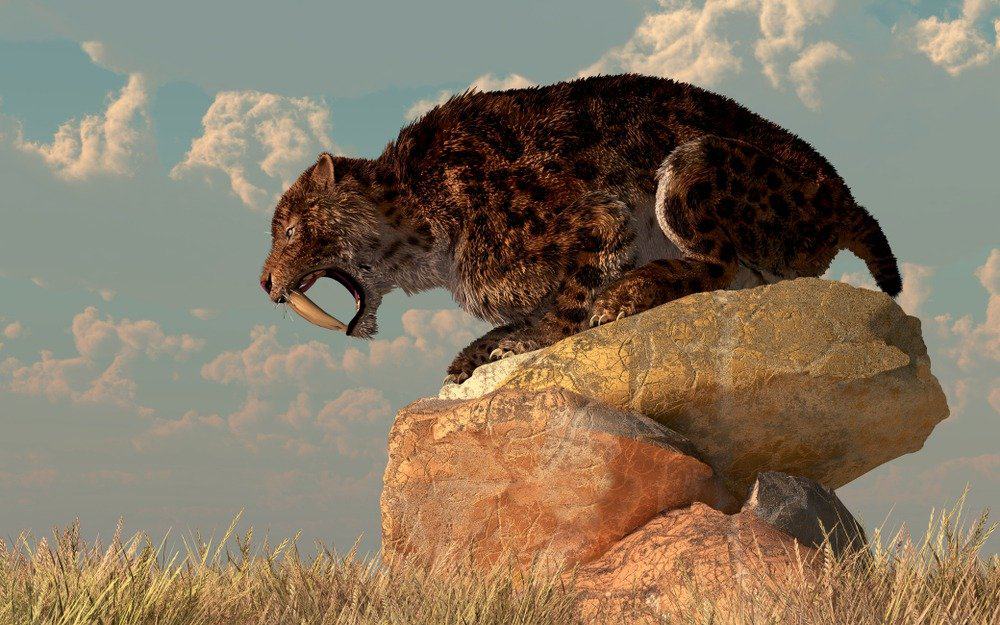
A saber tooth tiger’s pointed teeth reached 7 inches in length
©Daniel Eskridge/Shutterstock.com
The saber tooth tiger became extinct 10,000 years ago during the last ice age. They got their name from their sensational 7-inch long teeth! These long, pointed teeth sat in the upper jaw and were so large they could open their mouths 120 degrees to clamp down on prey. Modern cats can only open their jaws by 60 degrees!
Saber tooth tigers hunted horses, bison, ground sloth, and other mammals on the grasslands and plains of North and South America. There were three sub-species of saber-toothed tigers. Experts think they were all similar to lions in color and shape, but they were most closely related to our modern-day clouded leopards.
2. Tasmanian Tiger
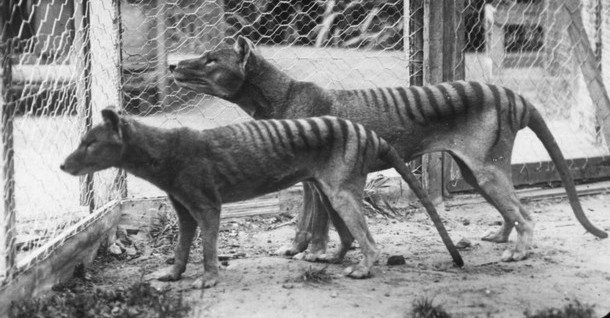
Tasmanian Tigers were stripy carnivorous marsupials.
©public domain – License
As the name suggests, Tasmanian tigers were native to Tasmania, Australia, and New Guinea. They weren’t tigers at all but carnivorous marsupials!
They were about the same size as a Labrador dog and weighed 30kgs, but their distinctive dark tiger stripes were most recognizable. Unfortunately for the Tasmanian tiger, this cool stripy skin led to their eventual extinction by overhunting.
Cash bounties were put on Tasmanian tigers because they preyed on livestock. It’s also possible that diseases and animals introduced by colonists contributed to their extinction.
Sometime between 1910 and 1920, the last wild Tasmanian tiger was killed, and the final one of the species died in Hobart Zoo in 1936.
3. Quagga
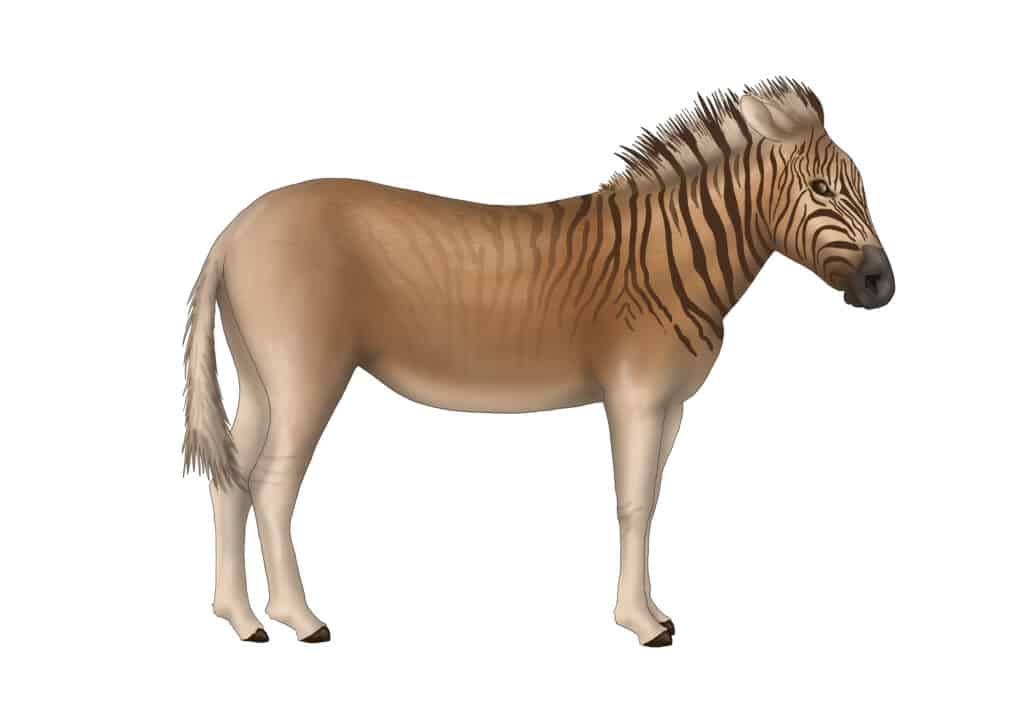
The quagga is cool because it was the first animal to have its DNA studied in the 1980s!
©miha de/Shutterstock.com
Quaggas were a subspecies of plains zebra that inhabited South African grasslands, roaming in great herds. They had striped coats much like today’s zebra, but their stripes stopped below the neck.
The quagga is cool because it was the first animal to have its DNA studied in the 1980s! Scientists are trying to bring them back from extinction via The Quagga Project by breeding zebras with quagga-like attributes.
Quaggas were 101 inches (257 centimeters) in length and stood 50 inches (127 centimeters) tall. They were hunted by big cats but capable of dealing devastating blows from hard, sharp hooves. They became extinct because humans overhunted them for their stripy skin so that domesticated cattle could inhabit the Quaggas grassland.
The final wild quagga was killed in South Africa’s Free State in 1878, and the last quagga in captivity died in Amsterdam’s Artis Magistra Zoo in 1883.
Fingers crossed, The Quagga Project can bring this cool extinct animal back!
4. Dire Wolf
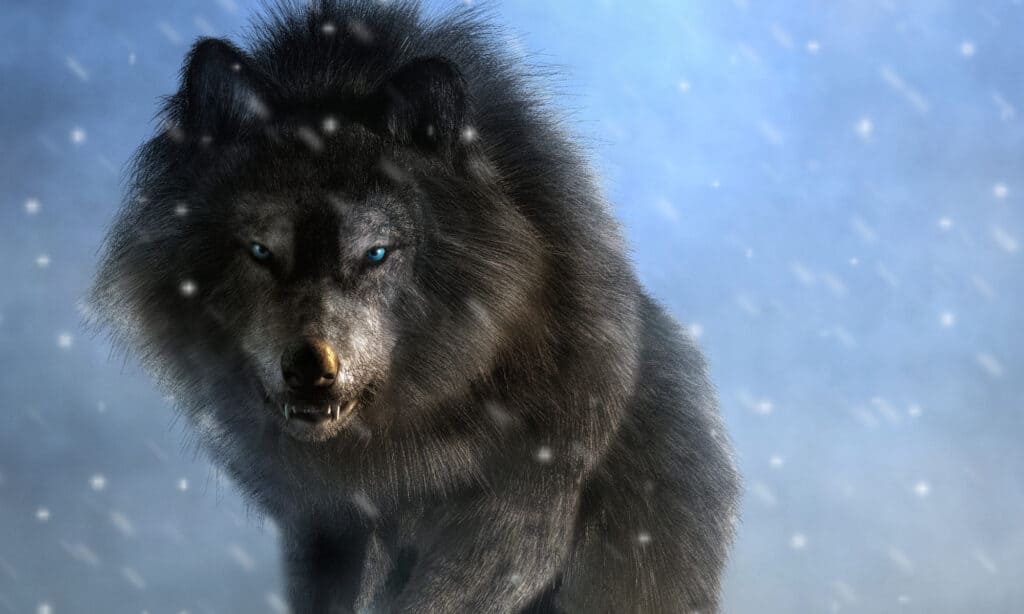
A dire wolf stood 69 inches (175 centimeters) tall at the shoulder, weighed 200 pounds, and was an apex predator of the Ice Ages.
©Daniel Eskridge/Shutterstock.com
25% larger than our gray wolf, the Ice Age dire wolf was a massive predator that hunted in packs. It preyed on deer, bison, mastodons, and horses but became extinct about 9,500 years ago, most likely due to climate change, lack of suitable prey, and human hunting.
Dire wolves were recreated for Game of Thrones, but not many people know they were real thousands of years ago. A dire wolf stood 69 inches (175 centimeters) tall at the shoulder, weighed 200 pounds, and was an apex predator of the Ice Ages.
It’s surely the coolest canine that’s ever existed!
5. Passenger Pigeon
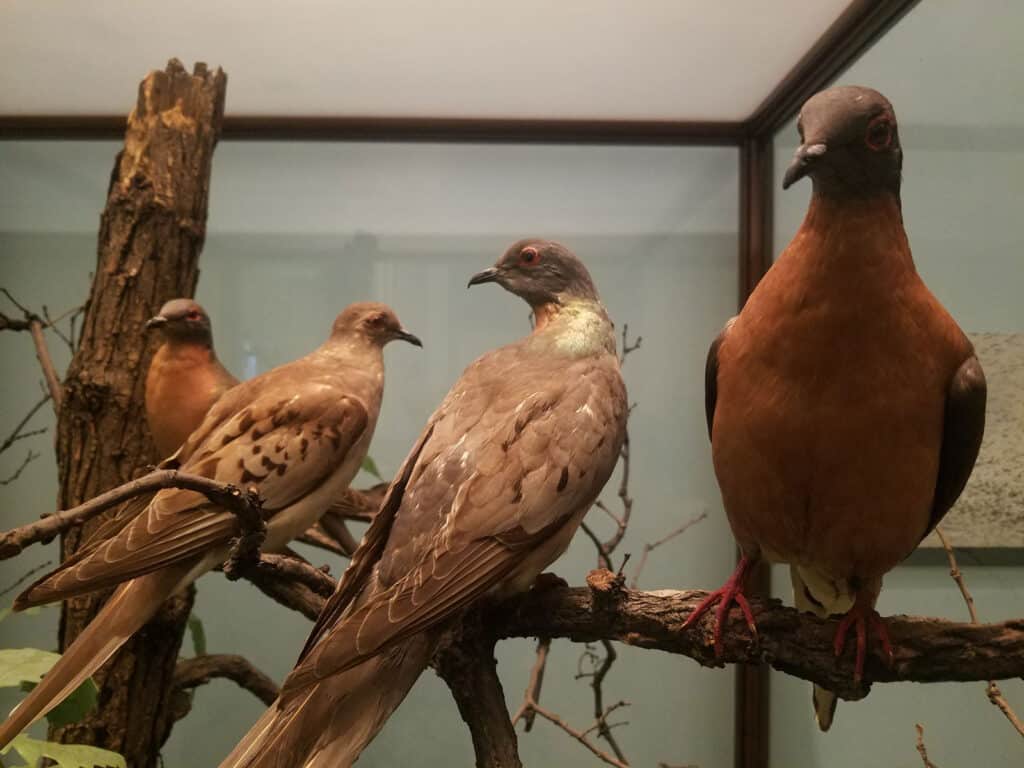
Passenger pigeons were intensively hunted by colonists.
©ChicagoPhotographer/Shutterstock.com
Can pigeons be cool? They certainly can!
The passenger pigeon was native to North America. It was the country’s wild pigeon, and there were huge numbers in the 19th century before colonists arrived.
This attractive bird looked like the mourning dove but was larger at 12.5 inches (32 centimeters). Male pigeons had a pink tint, a blue-gray head, and a long-pointed tail.
When colonists settled in America, they destroyed forests to create farmland. Because passenger pigeons nested together in large numbers, sometimes over 100 inhabited one tree, mass deforestation led to a large decrease in available habitat.
The pigeons were also easy to catch and a cheap meal. Passenger pigeons were intensively hunted for food, and they died out around 1900. The final passenger pigeon died in captivity in 1914.
Passenger pigeons are one of the best examples of human activity destroying a species.
6. West African Black Rhinoceros

The West African black
rhinoceros
could weigh a whopping 800-1300 kilograms (1763 – 2866 pounds).
©iStock.com/EcoPic
The West African black rhinoceros was a subspecies of black rhinoceros. They could reach 133 inches (338 centimeters) in length, 59 inches (150 centimeters) in height, and weigh a whopping 800-1300 kilograms (1763 – 2866 pounds). On its snout, there were two impressive horns. The largest was over 39 inches (100 centimeters), and the smaller horn closer to its face was 21 inches (55 centimeters).
It was the horns that led to their extinction. In Chinese medicine, rhino horns have medicinal properties, so they were intensively poached. For over a century, the population plummeted from a million to a few thousand. It’s thought poachers killed 98% between 1960 and 1995.
The government tried to preserve them, but their fortunes couldn’t be reversed. The very last West African black rhinoceros was seen in 2006 in Cameroon. They were declared extinct in 2011.
7. Baiji White Dolphin

Baiji dolphins were short-sighted and used echolocation for hunting fish.
©Institute of Hydrobiology, Chinese Academy of Sciences / public domain, Wikimedia Commons – License
The Chinese river dolphin was a short-sighted species of freshwater dolphin that inhabited the Yangtze River for 20 million years.
Adults reached eight feet and could weigh 500 pounds, which is about the same as a grizzly bear, and they used echolocation for hunting fish.
As China industrialized in the 1950s, heavier river transport, fishing, and hydroelectricity activity took a toll on the Baiji white dolphin, and its numbers plummeted. They’re not classed as extinct yet, but the last one was spotted in 2002, even though official surveyors have looked for many years.
The chances are slim, but let’s hope this playful and intelligent creature re-emerges soon.
These cool extinct animals all have something in common. Humans played a part in their extinction. It’s a clear warning that human activity can have devastating consequences on animals.
Summary of 7 Cool Extinct Animals
| # | Extinct Animal | Lived Until |
|---|---|---|
| 1 | Saber Tooth Tiger | 10,000 years ago |
| 2 | Tasmanian Tiger | 1936 |
| 3 | Quagga | 1883 |
| 4 | Dire Wolf | 9,500 years ago |
| 5 | Passenger Pigeon | 1914 |
| 6 | West African Black Rhinoceros | 2011 |
| 7 | Baiji White Dolphin | 2002 |
The photo featured at the top of this post is © 2630ben/Shutterstock.com
Thank you for reading! Have some feedback for us? Contact the AZ Animals editorial team.






